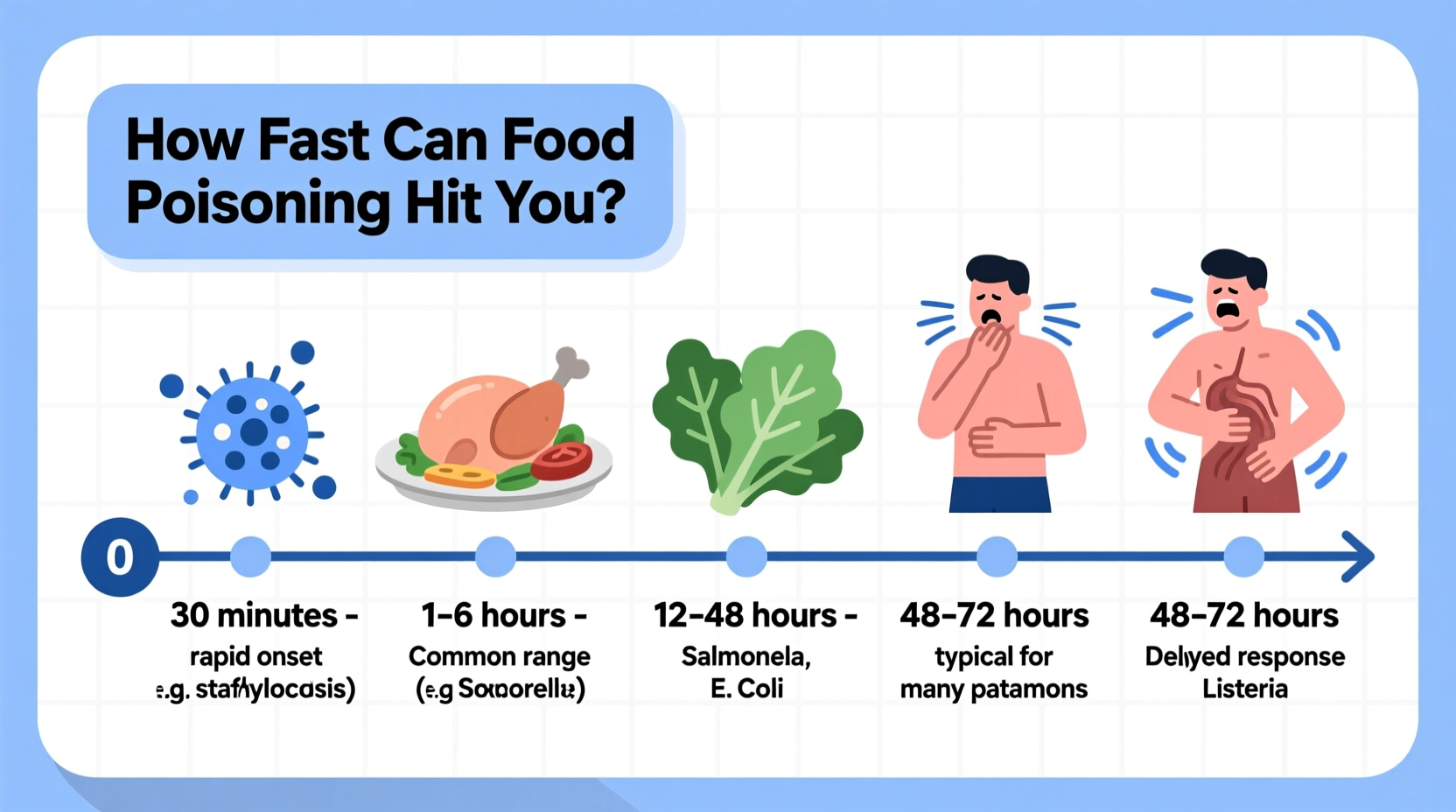Wondering how fast can food poisoning hit you after that questionable sushi or undercooked chicken? You're not alone—thousands search for this critical information daily when experiencing sudden stomach distress. Knowing the precise food poisoning onset time could mean the difference between managing symptoms at home or rushing to the emergency room. This guide delivers medically accurate timelines based on CDC and FDA data, so you can assess your situation with confidence.
Understanding the Critical First Hours
When your stomach starts churning, every minute feels like an eternity. The speed at which foodborne illness symptoms develop depends primarily on the specific pathogen or toxin involved. Here's what happens inside your body during those crucial early stages:
Immediately after consuming contaminated food, pathogens begin multiplying in your digestive system. Bacterial toxins work fastest—some can trigger your body's alarm systems within 30 minutes. Your gut lining detects the invaders and signals your brain, initiating protective responses like nausea and vomiting. This biological defense mechanism explains why how quickly food poisoning hits varies so dramatically between cases.
Pathogen-Specific Onset Timelines Revealed
Not all food poisoning strikes at the same speed. This medically verified timeline shows exactly how fast different foodborne illnesses manifest:
| Pathogen/Toxin | Typical Onset Time | Common Sources | Duration |
|---|---|---|---|
| Staphylococcus aureus | 30 min - 8 hours | Deli meats, salads, pastries | 1-2 days |
| Bacillus cereus (vomiting type) | 30 min - 6 hours | Fried rice, leftovers | 6-24 hours |
| Norovirus | 12-48 hours | Raw oysters, contaminated surfaces | 1-3 days |
| Salmonella | 6 hours - 6 days | Raw eggs, poultry | 4-7 days |
| E. coli (STEC) | 3-4 days | Undercooked beef, raw milk | 5-10 days |
| Listeria | 1-4 weeks | Soft cheeses, deli meats | Variable |
This comprehensive food poisoning symptom timeline comes directly from CDC surveillance data and FDA food safety guidelines. Notice how toxin-based illnesses (like Staphylococcus) strike fastest because they don't require bacterial growth in your system—they're pre-formed in the food.
Why Your Food Poisoning Timeline Might Differ
Several factors influence how fast food poisoning hits your system beyond the pathogen type:
- Your stomach acidity level - Lower acid levels (from medications like PPIs) allow pathogens to survive longer
- Amount consumed - Larger doses of contaminants typically accelerate symptom onset
- Immune status - Children, elderly, and immunocompromised individuals often experience faster progression
- Food matrix - Fatty foods can delay gastric emptying, potentially slowing toxin absorption
These variables explain why two people eating the same contaminated meal might experience symptoms hours apart. Understanding these factors affecting food poisoning onset helps explain seemingly inconsistent timelines.

Immediate Actions When Symptoms Strike
If you're experiencing sudden nausea after eating, follow these medically recommended steps within the first critical hours:
- Stop eating immediately - Give your digestive system a chance to recover
- Hydrate with electrolyte solutions - Use oral rehydration solutions, not just water
- Preserve evidence - Save any remaining suspect food for potential testing
- Track symptoms - Note exact onset time and progression pattern
- Avoid anti-diarrheal medications - Unless directed by a healthcare provider
Most importantly, recognize that how quickly food poisoning symptoms appear directly impacts your treatment options. Rapid-onset cases (under 2 hours) often indicate pre-formed toxins where antibiotics won't help, while delayed symptoms might respond to medical intervention.
When to Seek Emergency Medical Care
While most food poisoning cases resolve without treatment, certain red flags require immediate attention regardless of how fast food poisoning hits you:
- Symptoms appearing within 30 minutes of eating (possible chemical poisoning)
- Blood in vomit or stool
- Signs of dehydration (dark urine, dizziness, dry mouth)
- Fever above 101.5°F (38.6°C)
- Symptoms lasting longer than 3 days
- Pregnancy, infant, or elderly person affected
For vulnerable populations like pregnant women, the food poisoning onset timeline takes on special significance. Listeria, with its delayed 1-4 week onset, poses particular risks during pregnancy and requires prompt medical evaluation even with mild symptoms.
Preventing Future Episodes: Practical Food Safety
Understanding how fast food poisoning can hit you underscores the importance of prevention. Implement these evidence-based food safety practices:
- Follow the 2-hour rule: Refrigerate perishables within 2 hours (1 hour if above 90°F/32°C)
- Cook poultry to 165°F (74°C), ground meats to 160°F (71°C)
- Use separate cutting boards for raw meats and produce
- Wash hands thoroughly before handling food
- Be cautious with high-risk foods: raw shellfish, unpasteurized dairy, undercooked eggs
Remember that food poisoning incubation period varies significantly by pathogen, so don't assume you're safe just because symptoms haven't appeared within an hour. Some dangerous contaminants take days to manifest.
Tracking Your Recovery: What to Expect
Most foodborne illnesses follow predictable recovery patterns based on their food poisoning symptom onset time:
- Fast-acting toxins (30 min-8 hours): Typically resolve within 24 hours with proper hydration
- Bacterial infections (12+ hours): May last 3-7 days with possible complications
- Viral gastroenteritis: Usually peaks at 24-48 hours then gradually improves
If your symptoms persist beyond expected timelines for the suspected pathogen, consult a healthcare provider. Documenting your exact food poisoning onset time helps medical professionals make accurate diagnoses.











 浙公网安备
33010002000092号
浙公网安备
33010002000092号 浙B2-20120091-4
浙B2-20120091-4